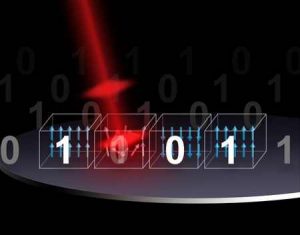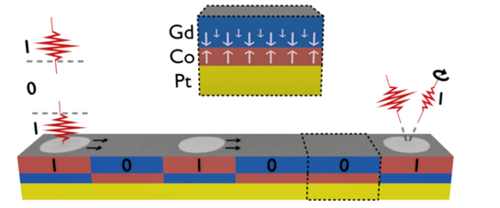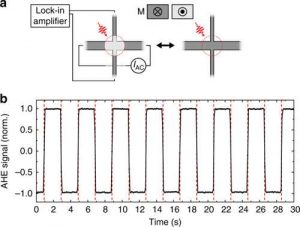R&D: Next Gen Photonic Memory Devices Are ‘Light-Written’, Ultrafast and Energy Efficient
Achieving all-optical switching in synthetic ferrimagnets - material system highly suitable for spintronic data applications - using single femtosecond laser pulses
This is a Press Release edited by StorageNewsletter.com on January 15, 2019 at 2:06 pmFrom Eindhoven University of Technology
Light is the most energy-efficient way of moving information.
All-optical switching. Data is stored in the form of ‘bits’,
which contains digital 0 (North Poles down) or 1 (North Poles up).
Data writing is achieved by ‘switching’ the direction of the poles
via the application of short laser pulses (in red).
Yet, light shows one big limitation: it is difficult to store. As a matter of fact, data centers rely primarily on magnetic hard drives. However, in these hard drives, information is transferred at an energy cost that is nowadays exploding. Researchers of the Institute of Photonic Integration of the Eindhoven University of Technology (TU/e) have developed a ‘hybrid technology’ which shows the advantages of both light and magnetic hard drives. Ultra-short (femtosecond) light pulses allows data to be directly written in a magnetic memory in a fast and highly energy-efficient way. Moreover, as soon as the information is written (and stored), it moves forward leaving space to empty memory domains to be filled in with new data. This research, published in Nature Communications, promises to revolutionize the process of data storage in future photonic integrated circuits.
Data are stored in hard drives in the form of ‘bits’, tiny magnetic domains with a North and a South pole. The direction of these poles (‘magnetization’), determines whether the bits contain a digital 0 or a 1. Writing the data is achieved by ‘switching’ the direction of the magnetization of the associated bits.
Synthetic ferrimagnets
Conventionally, the switching occurs when an external magnetic field is applied, which would force the direction of the poles either up (1) or down (0). Alternatively, switching can be achieved via the application of a short (femtosecond) laser pulse, which is called all-optical switching, and results in a more efficient and much faster storage of data.
Mark Lalieu, PhD candidate, Applied Physics Department, TU/e, said: “All-optical switching for data storage has been known for about a decade. When all-optical switching was first observed in ferromagnetic materials – amongst the most promising materials for magnetic memory devices – this research field gained a great boost’. However, the switching of the magnetization in these materials requires multiple laser pulses and, thus, long data writing times.“
Storing data a thousand times faster
Lalieu, under the guidance of Reinoud Lavrijsenand Bert Koopmans, was able to achieve all-optical switching in synthetic ferrimagnets – a material system highly suitable for spintronic data applications – using single femtosecond laser pulses, thus exploiting the high velocity of data writing and reduced energy consumption.
So how does all-optical switching compare to modern magnetic storage technologies? Lalieu said: “The switching of the magnetization direction using the single-pulse all-optical switching is in the order of picoseconds, which is about a 100 to 1000 times faster than what is possible with today’s technology. Moreover, as the optical information is stored in magnetic bits without the need of energy-costly electronics, it holds enormous potential for future use in photonic integrated circuits.”
‘On-the-fly’ data writing
On-the-fly data writing in racetrack memory devices.
The magnetic bits (1’s and 0’s) are written by laser pulses (red pulses, left side),
and data is transported along the racetrack towards
the other side (black arrows). In the future, data might be also
read-out optically (red pulses, right side).
In addition, Lalieu integrated all-optical switching with the so-called racetrack memory – a magnetic wire through which the data, in the form of magnetic bits, is efficiently transported using an electrical current. In this system, magnetic bits are continuously written using light, and immediately transported along the wire by the electrical current, leaving space to empty magnetic bits and, thus, new data to be stored.
Koopmans said: “This ‘on the fly’ copying of information between light and magnetic racetracks, without any intermediate electronic steps, is like jumping out of a moving high-speed train to another one. From a ‘photonic Thalys’ to a ‘magnetic ICE’, without any intermediate stops. You will understand the enormous increase in speed and reduction in energy consumption that can be achieved in this way“.
What’s next?
This research was performed on micrometric wires. In the future, smaller devices in the nanometer scale should be designed for better integration on chips. In addition, working towards the final integration of the photonic memory device, the Physics of Nanostructure group is currently also busy with the investigation on the read-out of the (magnetic) data, which can be done all-optically as well.
Reference
‘Integrating optical switching with spintronics’ by M.L.M. Lalieu, R. Lavrijsen and B. Koopmans is published online in Nature Communications. Lalieu is a PhD candidate in the Physics of Nanostructures group of the Department of Applied Physics. Lalieu will defend his PhD thesis on March 11th2019.
Article: Integrating all-optical switching with spintronics
Nature Communications has published an article written by M. L. M. Lalieu, R. Lavrijsen, B. Koopmans Department of Applied Physics, Institute for Photonic Integration, Eindhoven University of Technology, P.O. Box 513, 5600 MB, Eindhoven, The Netherlands .
Deterministic single-pulse AOS in a Pt/Co/Gd racetrack. a Schematic overview of the AOS measurement in a Hall cross on the Pt/Co/Gd wire. A small AC current is applied along the wire, while the resulting anomalous Hall voltage is measured across the legs using a lock-in amplifier. Exciting the cross by subsequent single linearly polarized laser pulses toggles the magnetization in the exposed region (dotted circle) up and down. b Measurement of the normalized AHE signal as a function of time during laser-pulse excitation at a repetition rate of 0.5 Hz. No external field was applied during the measurement
Abstract: “All-optical switching (AOS) of magnetic materials describes the reversal of the magnetization using short (femtosecond) laser pulses, and received extensive attention in the past decade due to its high potential for fast and energy-efficient data writing in future spintronic memory applications. Unfortunately, the AOS mechanism in the ferromagnetic multilayers commonly used in spintronics needs multiple pulses for the magnetization reversal, losing its speed and energy efficiency. Here, we experimentally demonstrate on-the-fly single-pulse AOS in combination with spin Hall effect (SHE) driven motion of magnetic domains in Pt/Co/Gd synthetic-ferrimagnetic racetracks. Moreover, using field-driven-SHE-assisted domain wall (DW) motion measurements, both the SHE efficiency in the racetrack is determined and the chirality of the optically written DW’s is verified. Our experiments demonstrate that Pt/Co/Gd racetracks facilitate both single-pulse AOS as well as efficient SHE-induced domain wall motion, which might ultimately pave the way towards integrated photonic memory devices.“















 Subscribe to our free daily newsletter
Subscribe to our free daily newsletter
